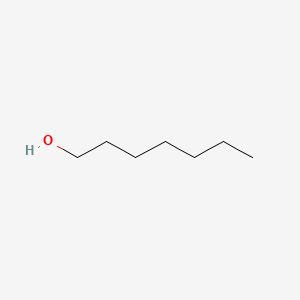| MeSH term | MeSH ID | Detail |
|---|---|---|
| Ventricular Dysfunction, Left | D018487 | 33 associated lipids |
| Tachycardia, Ventricular | D017180 | 9 associated lipids |
| Reperfusion Injury | D015427 | 65 associated lipids |
| Wounds, Gunshot | D014948 | 2 associated lipids |
| Tachycardia, Ectopic Atrial | D013612 | 1 associated lipids |
| Radiation Injuries, Experimental | D011833 | 11 associated lipids |
| Occupational Diseases | D009784 | 42 associated lipids |
| Neovascularization, Pathologic | D009389 | 39 associated lipids |
| Hypertension, Pulmonary | D006976 | 32 associated lipids |
| Hypertension | D006973 | 115 associated lipids |
n-heptanol
N-heptanol is a lipid of Fatty Acyls (FA) class. N-heptanol is associated with abnormalities such as Corneal Neovascularization. N-heptanol often locates in Epithelium and Structure of corneal epithelium. The related lipids are Heptanol.
Cross Reference
Introduction
To understand associated biological information of n-heptanol, we collected biological information of abnormalities, associated pathways, cellular/molecular locations, biological functions, related genes/proteins, lipids and common seen animal/experimental models with organized paragraphs from literatures.
What diseases are associated with n-heptanol?
n-heptanol is suspected in Corneal Neovascularization and other diseases in descending order of the highest number of associated sentences.
Related references are mostly published in these journals:
| Disease | Cross reference | Weighted score | Related literature |
|---|
Possible diseases from mapped MeSH terms on references
We collected disease MeSH terms mapped to the references associated with n-heptanol
PubChem Associated disorders and diseases
What pathways are associated with n-heptanol
There are no associated biomedical information in the current reference collection.
PubChem Biomolecular Interactions and Pathways
Link to PubChem Biomolecular Interactions and PathwaysWhat cellular locations are associated with n-heptanol?
Visualization in cellular structure
Associated locations are in red color. Not associated locations are in black.
Related references are published most in these journals:
| Location | Cross reference | Weighted score | Related literatures |
|---|
What functions are associated with n-heptanol?
There are no associated biomedical information in the current reference collection.
What lipids are associated with n-heptanol?
Related references are published most in these journals:
| Lipid concept | Cross reference | Weighted score | Related literatures |
|---|
What genes are associated with n-heptanol?
There are no associated biomedical information in the current reference collection.
What common seen animal models are associated with n-heptanol?
There are no associated biomedical information in the current reference collection.
NCBI Entrez Crosslinks
All references with n-heptanol
Download all related citations| Authors | Title | Published | Journal | PubMed Link |
|---|---|---|---|---|
| Beauchamp P et al. | Electrical propagation in synthetic ventricular myocyte strands from germline connexin43 knockout mice. | 2004 | Circ. Res. | pmid:15192022 |
| pmid:15193866 | ||||
| Nishida T et al. | Interleukin 6 facilitates corneal epithelial wound closure in vivo. | 1992 | Arch. Ophthalmol. | pmid:1520119 |
| Rembold M and Wittbrodt J | In vivo time-lapse imaging in medaka--n-heptanol blocks contractile rhythmical movements. | 2004 | Mech. Dev. | pmid:15210200 |
| Matchkov VV et al. | Junctional and nonjunctional effects of heptanol and glycyrrhetinic acid derivates in rat mesenteric small arteries. | 2004 | Br. J. Pharmacol. | pmid:15210581 |
| Rodriguez-Sinovas A et al. | Enhanced effect of gap junction uncouplers on macroscopic electrical properties of reperfused myocardium. | 2004 | J. Physiol. (Lond.) | pmid:15218064 |
| pmid:15268196 | ||||
| Zhou Q et al. | [Repellent effect of volatile oil from whitefly (Syngonium podophyllum) on aphids and its chemical constituents]. | 2004 | Ying Yong Sheng Tai Xue Bao | pmid:15320409 |
| pmid:15350063 | ||||
| Do CW et al. | cAMP inhibits transepithelial chloride secretion across bovine ciliary body/epithelium. | 2004 | Invest. Ophthalmol. Vis. Sci. | pmid:15452071 |
